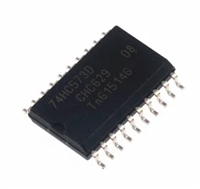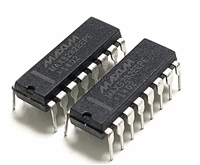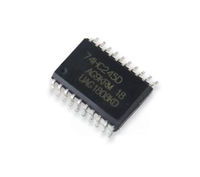AD22105
OUTPUT SECTION
Response of the AD22105 internal die temperature to abrupt
changes in ambient temperatures can be modeled by a single
time constant exponential function. Figure 11 shows typical
response plots for moving and still air. The time constant, τ
(time to reach 63.2% of the final value), is dependent on θJA and
the thermal capacities of the chip and the package. Table I lists
the effective τ for moving and still air. Copper printed circuit
board connections were neglected in the analysis; however, they
will sink or conduct heat directly through the AD22105’s solder
plated copper leads. When faster response is required, a therm-
ally conductive grease or glue between the AD22105 and the
surface temperature being measured should be used.
The output of the AD22105 is the collector of an NPN transistor.
When the ambient temperature of the device exceeds the
programmed setpoint temperature, this transistor is activated
causing its collector to become a low impedance. A pull-up
resistor, such as the internal 200 kΩ provided, is needed to
observe a change in the output voltage. For versatility, the
optional pull-up resistor has not been permanently connected
to the output pin. Instead, this resistor is undedicated and
connects from Pin 7 (VS) to Pin 1 (RPULL-UP). In order to use
RPULL-UP a single connection should be made from Pin 1
(RPULL-UP) to Pin 2 (OUT).
The 200 kΩ pull-up resistor can drive CMOS loads since
essentially no static current is required at these inputs. When
driving “LS” and other bipolar family logic inputs a parallel
resistor may be necessary to supply the 20 µA–50 µA IIH (High
Level Input Current) specified for such devices. To determine
the current required, the appropriate manufacturer’s data sheet
should be consulted. When the output is switched, indicating an
over temperature condition, the output is capable of pulling
down with 10 mA at a voltage of about 375 mV. This allows for
a fan out of 2 with standard bipolar logic and 20 with “LS”
family logic.
Table I. Thermal Resistance (SO-8)
Medium
JA (؇C/Watt)
(sec)*
Moving Air**
100
3.5
Without Heat Sink
Still Air
190
15
Without Heat Sink
NOTES
**The time constant is defined as the time to reach 63.2% of the final tempera-
ture change.
Low power indicator LEDs (up to 10 mA) can be driven
directly from the output pin of the AD22105. In most cases a
small series resistor (usually of several hundred ohms) will be
required to limit the current to the LED and the output
transistor of the AD22105.
**1200 CFM.
USING THE AD22105 AS A COOLING SETPOINT
DETECTOR
The AD22105 can be used to detect transitions from higher
temperatures to lower temperatures by programming the
setpoint temperature 4°C greater than the desired trip point
temperature. The 4°C is necessary to compensate for the
nominal hysteresis value designed into the device. A more
precise value of the hysteresis can be obtained from Figure 6. In
this mode, the logic state of the output will indicate a HIGH for
under temperature conditions. The total device error will be
slightly greater than the specification value due to uncertainty in
hysteresis.
MOUNTING CONSIDERATIONS
If the AD22105 is thermally attached and properly protected, it
can be used in any measuring situation where the maximum
range of temperatures encountered is between –40°C and
+150°C. Because plastic IC packaging technology is employed,
excessive mechanical stress must be avoided when fastening the
device with a clamp or screw-on heat tab. Thermally conductive
epoxy or glue is recommended for typical mounting conditions.
In wet or corrosive environments, an electrically isolated metal
or ceramic well should be used to protect the AD22105.
APPLICATION HINTS
EMI Suppression
THERMAL ENVIRONMENT EFFECTS
Noisy environments may couple electromagnetic energy into the
RSET node causing the AD22105 to falsely trip or untrip. Noise
sources, which typically come from fast rising edges, can be
coupled into the device capacitively. Furthermore, if the output
signal is brought close the RSET pin, energy can couple from the
OUT pin to the RSET pin potentially causing oscillation. Stray
capacitance can come from several places such as, IC sockets,
multiconductor cables, and printed circuit board traces. In some
cases, it can be corrected by constructing a Faraday shield
around the RSET pin, for example, by using a shielded cable with
the shield grounded. However, for best performance, cables
should be avoided and the AD22105 should be soldered directly
to a printed circuit board whenever possible. Figure 13 shows a
sample printed circuit board layout with low inter-pin capaci-
tance and Faraday shielding. If stray capacitance is unavoidable,
and interference or oscillation occurs, a low impedance capaci-
tor should be connected from the RSET pin to the GND pin.
This capacitor must be considerably larger than the estimated
stray capacitance. Typically several hundred picofarads will cor-
rect the problem.
The thermal environment in which the AD22105 is used
determines two performance traits: the effect of self-heating on
accuracy and the response time of the sensor to rapid changes in
temperature. In the first case, a rise in the IC junction tempera-
ture above the ambient temperature is a function of two variables:
the power consumption of the AD22105 and the thermal
resistance between the chip and the ambient environment, θJA.
Self-heating error can be derived by multiplying the power
dissipation by θJA. Because errors of this type can vary widely for
surroundings with different heat sinking capacities, it is
necessary to specify θJA under several conditions. Table I shows
how the magnitude of self-heating error varies relative to the
environment. A typical part will dissipate about 230 µW at
room temperature with a 3.3 V supply and negligible output
loading. In still air, without a “heat sink,” Table I indicates a
θJA of 190°C/W, which yields a temperature rise of 0.04°C.
Thermal rise of the die will be considerably less in an environ-
ment of turbulent or constant moving air or if the device is in
direct physical contact with a solid (or liquid) body.
REV. 0
–7–






 74HC573三态非易失锁存器(Latch)资料手册参数分析
74HC573三态非易失锁存器(Latch)资料手册参数分析

 MAX3232 RS-232电平转换器资料手册参数分析
MAX3232 RS-232电平转换器资料手册参数分析

 MAX485 RS-485/RS-422收发器资料手册参数分析
MAX485 RS-485/RS-422收发器资料手册参数分析

 74HC245八路双向总线收发器:资料手册参数分析
74HC245八路双向总线收发器:资料手册参数分析
